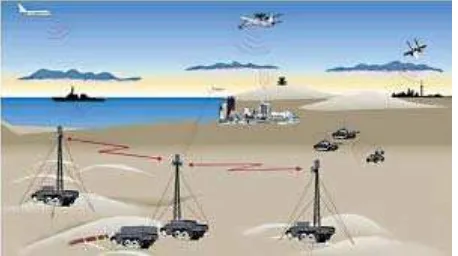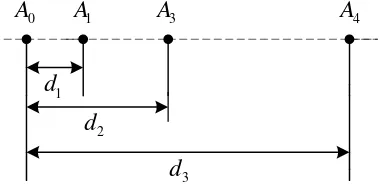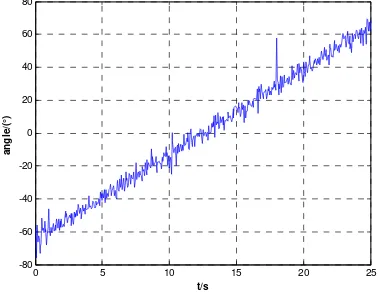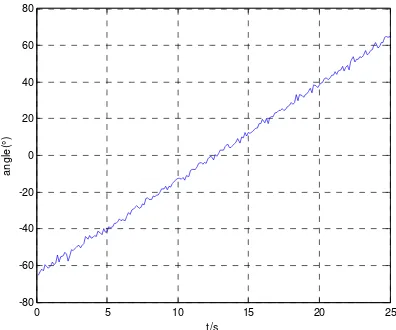DOI: 10.12928/TELKOMNIKA.v12i1.2023 63
Improved Ambiguity-Resolving for Virtual Baseline
Hailiang. Song*, Yongqing. Fu, Xue. Liu
College of Information and Communication Engineering, Harbin Engineering University Harbin, 150001, China
*Corresponding author, email:songhailiang1984@163.com
Abstract
A novel phase interferometer method based on virtual baseline is proposed for technical difficulty in resolving angle ambiguity and antenna layout. In this method, only two baselines are set to solve the problem of angle ambiguity. In high noise areas, there are large numbers of outliers which lead to angle error in the measured data, and a way to detect and eliminate the outliers is applied to improve the effect of solving ambiguity. The simulation results show that the improved method could effectively correct the error of fuzzy phase difference and increase the probability of ambiguity-resolving. Duo to its simple equipment and easy to implement, the proposed method might have certain guiding significance to engineering applications.
Keywords: virtual baseline; resolving ambiguity; phase difference; outliers
1. Introduction
With the development of the electronic counter-measures technology and the missile defense technology, the traditional Air-borne radar systems have encountered more and more serious threats in modern high-tech warfare, due to its weak electromagnetic invisibility, weak anti-reconnaissance capability and poor anti-jamming capability. Previous single radar seeker with bearings-only tracking system can not meet the needs of modern warfare, As the consummation and complement of active detection systems, passive location and tracking system is becoming an important part of the multi-mode radar seeker and has been paid much more attention by many countries. The passive observation mode by single observer has many advantages, such as excellent invisibility, simplicity in the facility, large effective radius and wide applicability [1-2].
Figure 1. Presentation of passive location
phase difference, so as to calculate the radiation direction. If electronic warfare system adopts the traditional compare-breadth technology for direction finding, it only can measure the target azimuth with poor precision (12~15. R.M.S), and can't meet the requirements of passive location, therefore, with the direction finding of the high resolution precision technology, phase interferometer direction finding technology can reach high precision(0.5. R.M.S), and it is widely applied in the passive direction finding system. But phase interferometer can only measure the value of phase difference within
-
,
, so there is a contradiction between direction finding accuracy and the maximum ambiguity.In order to solve this contradiction, the most multiple baseline interference instruments are used for measuring angle, and the solution is using the combination of long and short baseline, the long baseline assurance the direction finding accuracy, and the short baseline for the phase ambiguity. In view of the fuzzy solutions for the baseline interferometer angle measuring algorithm, there are many scholars focus on the research. Liu and Dong [4]-[5] analyze the feasibility of the virtual matrix element method to resolving ambiguity theoretically which based on a virtual array transformation method and the least squares estimate of the virtual array element method. Jiang.etc [6] proposed a phase interferometer antenna array's baseline meter method by a successive recursive algorithm of fuzzy solution, and derived the analytical expression of the baseline length, analyzed the relationship between the major indexes of the phase interferometer (accuracy of Angle measuring, an antenna spacing, phase measurement error) and the antenna array parameters (baseline number, virtual baseline, baseline length). Zhou.etc [7]-[8] using the Chinese remainder theorem as the solution of the fuzzy, and study the conditions of the correct solution of fuzzy in noise environment, then borrow from the principle of the length of baseline interferometer for angle measuring which uses short baseline solution to the problem of phase ambiguity, long baseline improves the accuracy of measuring angle, the length of baseline match selected, angle measuring ability and anti-noise performance are analyzed and simulated.
But this approach requires the length of short baseline to be less than
/2
. Especially for high frequency signal, the wavelength will be very small, and it makes the size of the antenna array should be very small. As a result, it leads to decrease of the antenna gain and antenna mutual coupling. Meanwhile, the too small size of short baseline length increases the cost of system equipment, adds complexity of data processing, and puts forward the high requirements of antenna installation and measurement accuracy [9]-[10]. A multiple baseline phase difference solution based on distance varies is proposed by Gong and Yang [11]-[12], but as a result to its multidimensional integer search, this solution needs huge computation. And yet, it is desperately needed that the algorithm of resolving ambiguity has easy implementation and quick operation in single passive localization and tracking system. The other commonly used method of resolving ambiguity is the dual baseline system based on remainder theorem, this way can ensure high precision, but the distance between the antennas must be strictly co-prime.A virtual baseline method is present to resolving ambiguity with few numbers of antennas, easy to lay- out to for antennas and high precision [13]. However, the accuracy of this method is affected seriously by the shorter baseline, and in a real environment, larger noise has a great influence for classical method of resolving ambiguity, the effect of ambiguity resolution is reduced under low SNR.
Thus, an improved method is put forward to increased ambiguity-resolving ability of virtual baseline. The characteristic of the virtual baseline is that the influence of the noise mainly exists in the short baseline measurement
Therefore, a better method to improve virtual baseline is undoing noise in the short baseline measurement, and an improvement method is put forward automatically, This method can determine the outliers eliminating outliers which are caused by strong noise according to certain criteria, then eliminate them and get unambiguous angle measurements of higher precision.
2. The Principle of Phase Interferometer
difference of signal wave arrival, which is caused by adjacent arrays. Single baseline direction principle is shown in Figure 2.
0
A A1
Figure 2. Phase interferometer of single baseline
The space wave is received by antenna array units as
A
0 andA
1, the phase difference and angle of arrival are as follows.0
=2
d
sin /
(1)
= arcsin
/2
d
(2)
is the signal phase difference,
as the length of signal wave.d
means the distance between the two antenna array units.
is the arrival angle. Ifd
> /2
,then
may be greater than2
,and it leads to the phase ambiguity.In the multiple baseline phase interferometer system, the short baseline
( < /2)
d
is usually used to solve the problem of phase ambiguity, and the long baseline to ensure the high precision of direction finding. The below Figure is a sample of one dimensional phase interferometer of three baselines.1
d
2
d
3
d
0
A
A
1A
3A
4Figure 3. Phase interferometer of multiple baselines
In the above diagram, the three baselines are made up by four array units as
A
0A
1A
23
A
, and the length isd
1d
2d
3 respectively. The longest of them isd
3, andd
1is the shortest. Combination with the formula (1), we learn that:=2
sin / =2
+
i
d
ik
i i
(3)In the above formula,
k
i
d
i/
,i
=1 2 3
、、,
i is a phase difference of differentsimultaneous equations, and also
3at last. The arrival angle
can be calculated by the formula (2) accordingly.3. Improved Ambiguity-Resolving For Virtual Baseline
3.1 The direction finding rinciple of virtual baseline interferometer
Multiple baseline interferometer for direction finding can provide high precision bearing, and avoid the phase ambiguity problem. The baseline interferometers of cosine law and length ratio are the two most studied methods. These methods, in algorithm performance, can satisfy the demands of general direction, but there are defects for the two solutions. The method of cosine law[14] requires the length ratio to be co-prime, and it lead that the result is sensitive to phase error; the other way is complex for its multistage operation. Both methods need more units of antenna for ambiguity resolution. Generally, when the array element number is more than five, the direction finding accuracy can be assured. In applications of size limitation, these ways are not suitable for long baseline system.
Virtual baseline method is to use two different baseline phase to obtain a short baseline length by subtracting, and if the length of obtained short baseline is less than the half wavelength of signal, the direction finding result can be obtained without fuzzy phenomenon. Then, the higher precision value of direction finding can be achieved by the operators of solving ambiguity for long baselines.
Virtual base method is composed of three antennas which constitute double baselines. It is shown in Figure 3. However, the relationship between the two baselines needs not be relatively prime, only needs to satisfy the following relation.
23
-
12 min/2
d
d
(4)1
A
A
2A
31
A
12
d
d
12
23
d
13
d
d
Figure 4. Phase interferometer principle of virtual baseline
Combination of interferometer direction finding principle, we can get the following message is from Figure 3
0
=2
d
sin / =2
d
12-
d
32sin / =2
k
0+
0
(5)1
=2
d
23sin / =2
k
1+
1
(6)2
=2
d
13sin / =2
k
2+
2
(7)Virtual method use short baseline, obtained by subtraction of the two long baselines, to solve the fuzzy problem of the long baseline phase difference. This method has less number of antenna, not strict installation and high accuracy measurement.
Although a virtual base method of angle measuring to solve the fuzzy problem of the longest baseline phase, the existence of each channel interferometer measurement error limits the maximum value of the baseline length ratio.
13 12 23 0 2 13 12 23 0 2 2
( /
)
( /
)
2
2
d
d
d
d
d
d
K INT
(8)
In the above formula,
d
ij is the distance of antenna array units fromi
toj
.
0is a phase difference of different baselines after resolving ambiguity,
2
is the observed value correspondingly.
0
and
2
are measurement error respectively .To obtain the correct value of
K
2, it need the measuring error had no effect for Integer operation of the formula 8, so the requirement must be satisfied:13 12 23 0 2
(
/
)
1
1
-2
2
2
d
d
d
(9)If measurement error meets the above conditions, the integer can get the correct value of
K
2. From formula 8,the error
0 of baseline interferometer measurement is amplified with13
/
23-12d
d
times. And the sum of the amplified error and the measurement error of the long baseline phase interferometer will have an impact on the value selection of K ,even the error of the virtual baseline phase interferometer measurement. Considering the accuracy of the phase difference measurement is almost equal between the channels. When thed
13/
d
23-12 is fixed, the requirements must be satisfied for the largest errors of phase difference measurement as:13 12 23
(
d
/
d
d
) 1
(10)The above formula can determine the allowed most large phase measuring error under the given baseline length ratio. If the baseline length ratio is set as 21, according to the formula 10, we can get
8.18
,then it can meet the requirements of the solution of fuzzy. However, such condition puts forward strict requirements on carrier phase measurements. Once the carrier phase measurement accuracy can not meet the requirement, it will lead wrong to the gain of K, even bring about the phenomenon of many errors for ambiguity resolutionwithout a certain method to suppress. As a result, angle measuring accuracy is greatly reduced.3.2 Improved virtual baseline solution for resolving ambiguity
Arithmetic:
Step1 : First, 100 consecutive measurements of virtual short baseline phase are collected, the top fifty values and the after fifty values are sorted by size respectively.
1 2 3 50 1s 2 3 50
51 52 53 100 51s 52 53 100
( ,
,
)=
,
,
(
,
,
)=
,
,
s s s
s s s
sort
sort
(11)In the above formula,
1s,
2s,
3s
100s means the measured values of the phase difference after sorting,
is a preset threshold from practical experience. If the following conditions is satisfied25s 26 75s 76
(
+
s)/2-(
+
s)/2
(12)The preset value for reference is
ref=(
75s+
76s)/2
, If(
25s+
26s)/2-(
75s+
76s)/2 >
,there are outliers in
25s,
26s,
75s,
76s,the preset data of reference needs to rethink, and continue to slide the storage unit, until find the initial value which meet the conditions.Step2 : Slid the storage unit and store 100 value of initial phase measurement, and then take an average of the 100 points.
100
=1
1
=
refk
N
(13)Compare the current defuzzified value of the interferometer measurement with the previous threshold. If the value is less than or equal to the threshold (the threshold value for the maximum error of two adjacent phase difference), while it needs to maintain the current measurements. Else, the threshold method is used to replace the current measured value.
: We can get the short baseline phase difference value with outliers eliminating, and the phase difference of high precision is derived by successive operation. Finally, the angle of incidence can be determined according to the formula (2).
4. Simulation Experiment
In order to verify the validity of the algorithm, we have experiments in the following
simulation environment: set the range of simulation angle as
[-65 ,65 ]
, angular velocity is5 /
s
Figure 5. The original virtual baseline phase difference
Figure 6. The improved virtual baseline phase difference
Figure 7. The original virtual baseline angle measurements
0 5 10 15 20 25 -200
-150 -100 -50 0 50 100 150 200
an
g
le/
(°
)
t/s
0 5 10 15 20 25 -200
-150 -100 -50 0 50 100 150 200
a
ngl
e
/(
°)
t/s
0 5 10 15 20 25 -80
-60 -40 -20 0 20 40 60 80
an
g
le/
(°)
Figure 8. The improved virtual baseline angle measurements
In Figure 5, there are a large number of outliers caused by interference, in which
abnormal value even more than
60
, and use this improved way to eliminate outliers and correct error, the results as shown in Figure 6. After processing, the error range of the measured value is greatly narrowed, outliers are completely eliminated and the measured value changes with in a small range. Figure 7 and 8 are the measured value of the angle before and after improvement respectively, it can be seen that improved method completely eliminates outliers of the isolated type existing in the measuring data. Due to the limited memory error correction mode, to some continuous abnormal values, when the wrong time is more than a certain length, this way will be fail to correct error, but increasing memory length will affect the real-time performance of the algorithm, so it need to choose the suitable length according to the application specific environment.In order to further verify the effect of the algorithm, 1000 Monte Carlo independent tests have been done to contrast the unimproved de-fuzzy effect to the improved result. Figure 9 shows the standard phase error curve with the change of phase noise.
Figure 9. The angular deviation Figure of improved algorithm
According to Figure 9, with the increase of channel noise error ,angle measurement error of original virtual baseline solution increases quickly, when the phase error increases to
0 5 10 15 20 25
-80 -60 -40 -20 0 20 40 60 80
t/s
an
gl
e(
°)
0 5 10 15 20 25 30 35 40 45 50
0 5 10 15 20 25 30 35 40 45
an
g
le
d
e
vi
at
io
n
/(
°)
20
, the standard deviation of measurement value is more than30
. After dealing with the outlier elimination, angle error is greatly reduced. When the channel phase noise error of up to50
, the improved measuring angular deviation remained under5
. Compared with the traditional virtual baseline solution, the improved algorithm significantly improves the data quality of angle measurement, and this is extraordinarily useful for subsequent further processing.5. Conclusions
In this paper, a new ambiguity resolution based on virtual baseline interferometer is proposed , the algorithm adopts the outliers eliminating to reduce the random error, and it improves the effect of solving ambiguity for the virtual baseline solution. Experimental results prove that this method is effective to improve angle measuring accuracy and can provide the follow-up positioning processing with high-precision measurement parameters. From the engineering point of view, this method has simple equipment, not strictly limited installing, and it can effectively deal with the contradiction of the direction finding accuracy and phase fuzzy. So, this method is of great reference value to practical engineering. And because of the delay of data storage and processing, the real-time performance of the algorithm will be influenced to a certain degree, this request that selecting storage cycle should be considered under in real- time performance and improving effect. With the hardware development of the digital processing technology, this problem will be solved completely in the future.
References
[1] Liu Wei, Zou Jian,et al. Kalman filter Localization algorithm based on SDS-TWR ranging.
TELKOMNIKA. 2013; 11(3): 1436-1448.
[2] Z. K. Sun, F. C. Guo. A passive location and tracking technology by single observe. ChangSha:
National Defence Industry Press. 2008: 187-198.
[3] Singh, Vinai, Yadav, Ajit Kumar Singh ,et al. Semiconductor-optical-amplifier Mach-Zehnder interferometer based optical networks. TELKOMNIKA. 2013; 11(1): 525-535.
[4] LU J M. Fuzzy solution based on least squares virtual array algorithm. Electronic Science and
Technology, 2009; 1(11): 9-11.
[5] DONG. G .Y, TAO. H. H, LIAO. G .S. The feasibility analysis of ambiguity solving with virtual arrays.
Journal of Electronics and Information Technology. 2010; 1(6): 1493-1496.
[6] JIANG X J, GAO X, SHEN Y. Design of multi-baseline Interferometer. Electronic Information Warfare Technology. 2008; 1(4): 39-45.
[7] ZHOU Y Q, CHEN ZH, HUANG F K, et al. Algorithm of Solving Multi-baseline Interferometer Phase
Difference Ambiguity in Noisy Circumstance. Journal of Electronics and Information Technology.
2005; 3(2): 259-261.
[8] ZHOU Y Q, HUANG F K. Solving ambiguity problem of digitized multi-baseline interferometer under noisy circumstance. Journal of China Institute of Communications. 2005; 1(8): 16-21.
[9] W.J. Si, P.Chu. Research on the ways of solving direction finding ambiguity for interferometer. Applied Science and Technology. 2007; 34(9): 55-57.
[10] L. Balogh, I. Kollar. Angle of arrival estimation based on interferometer principle. IEEE International Symposium on Intelligent Signal Processing. 2003; 31(4): 219-223.
[11] X. Y. Gong, J. Q. Yuan and X. C .Sun. Analysis of the method in solving phase difference variety ambiguity with stagger distance difference.Signal Processing. 2003; 19(4): 309-311.
[12] J. Yang, B. Luo and S.J .Xia. Research on algorithm of solving stagger-baseline interferometer phase difference ambiguity. Aerospace Electronic Warfare. 2012; 28(3): 31-34.
[13] W. J. Si. A New Data Processing Algorithm for Angle measurement with Interferometer. Transactions of Beijing Institute of Technology. 2007; 1(28): 45-47.
[14] C.J. Xia. Resolving ambiguity technique based on remainder theorem in interferometer receiver.
Shipboard Electronic countermeasure. 2006; 8(4): 70-72.
[15] X. Cui. Phase Interferometer Improvement based on Virtual Baseline. Communications Technology.
2011; 7(44): 89-91.
[16] Y. T. Han, W. P. Pan, et al. Detection and correction of interferometer ambiguity-resolving abnormal value. Transactions of Beijing Institute of Technology. 2012; 8(32): 850-854.
[18] Y.T.Han, S. L. Wei, et al. The new ambiguity-solving method of interferometer under point Target.
Journal of Telemetry,Tracking and Command. 2012; 33(1): 2-8.
[19] Y. T. Han, S.L.Wei, et al. Ambiguity-resolving method of interferometer based on phase difference with vector average. Journal of Electronic Measurement and Instrument. 2011; 25(10): 843-849.




